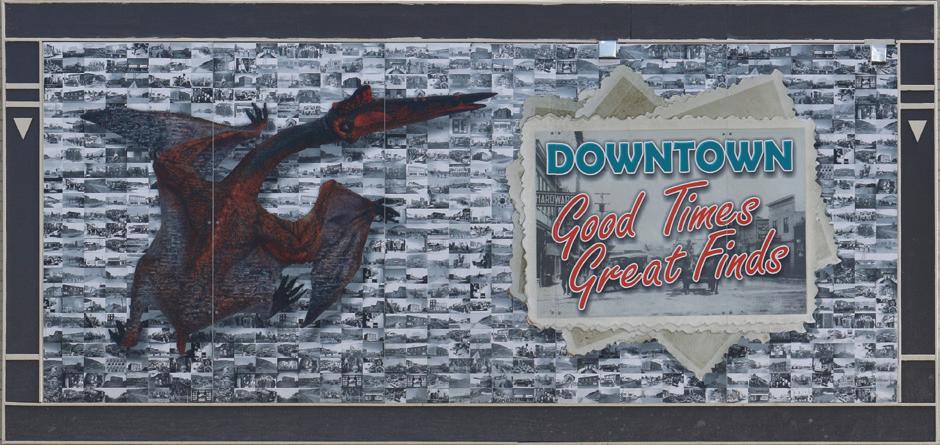
4 minute read
Experience Indigenous Culture
Amelie experiences the dino-thrill at Devil’s Coulee museum, near Warner, Ab

Advertisement
Dinosaur Provincial Park, Courtesy of Tanya Koob

Royal Tyrrell Museum, Courtesy of Canadian Tourism Commission
Shhhhh…can you hear the leaves rustling? Wait for it…the ground begins trembling and suddenly you’re face to face with a T. Rex, Stegoceras or maybe a Sabre-Toothed Tiger.
Does it sound scary, exciting, adventurous? Then pack your imagination, because it’s time for a grandcation, which is an exclusive vacay for grandparents and grandchildren. And Southern Alberta is the place to be.
Our journey begins in Cowley, Alberta where Black Beauty was discovered. No, it isn’t the famous horse. It is a very well preserved skeleton of a T. rex discovered three km north of Cowley on the Crowsnest River. Aptly named for the fossil’s shiny black colour, Black Beauty’s skull bones have been used to illustrate the concept of parasitic infections in dinosaurs.
This T. rex, specimen features 85 original bones and is the 14 th most complete known T. rex in the world. The skeleton is on display at the Royal Tyrell Museum in Drumheller. It’s also reinvented in an iron and metal 4.5 m statue in Cowley.
It’s astonishing to think that dinosaurs just like the legendary T. rex were little critters born from an egg. Devil’s Coulee, about 70 km south Lethbridge on Hwy 4, produced the first and largest dinosaur nesting ground discovered in Canada. Once part of an inland sea, the dino eggs at Devil’s Coulee are those of the Duck-Billed Hypacrosaurus. Four nests were unearthed. Miraculously, one egg contained a fully developed embryo about 40 cm long.
Devil’s Coulee is the only area in the country holding so many nests, eggs and embryos that it’s considered to be one of the top three best places in North America for such a find. A trip to the Devil’s Coulee Dinosaur & Heritage Museum in Warner where the eggs are displayed is a must stop on the grandcation.
Over the millennia some dinosaurs started stepping out in style. The feathered Ornithomimus, discovered in Southern Alberta boasted fluffy feathers on its bones connecting the legs to the breast. Fossils for this beast have never been discovered in North America before and the feathers appear as tiny black lines on the fossils.
This 75-million-year-old hotty probably looked like a plucked goose, but don’t take our word for it. Make the Royal Tyrrell Museum a stop on your grandcation and see for yourself.
Speaking about birds of a feather, a 76-million-year-old, nearly complete Saurornitholestes specimen was unearthed in the Dinosaur Provincial Park.
Better known as a raptor, Saurornitholestes, or “lizard-bird thief”, is a small-feathered meat eater previously known from only fragmentary remains. This is a significant discovery because a unique tooth believed to have evolved for preening feathers was discovered in the fossil record.
The tooth led to further evidence that the raptor lineage from North America, including the Saurornitholestes, is distinct from an Asian lineage that includes the famous Velociraptor.
Dinosaur Provincial Park is a UNESCO World Heritage site about 2.5 hours from Calgary, northeast ofBrooks. It wouldn’t be a grandcation without visiting this dinosaur goldmine. And even more rare is this fossil represents a new species in the triceratops family called Regaliceratops Peterhewsi.
The affectionately named Hellboy, after the comic book and movie character featured peculiar armour-plating with two small horns sticking out over its eyes, this 68-million-year-old fossil was found sticking out of a cliff along the Oldman River in Southern Alberta. It had a crown-like appearance with a halo of 5 sided plates, each spreading outward along a central spike. Horned dinosaurs haven’t been found in this part of the world before so scientists did a double take in the lab while freeing Hellboy from his confinement in rock. No grandcation is complete without a trip to the Calgary Zoo’s prehistoric park. Giant replicas of different dinosaur species can be seen lurking throughout the park. Visitors get a sense of what it would have been like eons ago in a world of giant predators, herbivores and plants.
Last but not least is Smilodon, more commonly known as the sabre-toothed tiger. Okay, Smilodon is not technically a dinosaur, but it’s equally magnificent. And fossils for this ice-age predator have never been found in Canada before.
Discovered near Medicine Hat, this extinct feline sported huge canines resembling steak knives. Interestingly, their teeth were fragile because they were flattened, and prone to breaking. Smilodon pinned down its prey, thus preventing any struggles that risked breaking teeth.
Whatever your plan is, get some family grandtime in and hit up some dinosaur treasure-troves in Southern Alberta. By: Kerri Robins

Good Times. Great Finds.
Drumheller is home to a terrific variety of murals!
And some, like the one pictured here, got a fresh
look recently. Located at Hwy 9 and 3 rd Ave, this new
mural is a collage of historical pictures of Drumheller’s interesting past. Contributor Deb Jungling, from Jungling Works feels it not only appeals to locals, but attracts tourists to the downtown core.
towering high over drumheller... Celebrating 20 years!

the World’s Largest Dinosaur is designed for dino-enthusiasts of all ages to explore, inside and out. Climb 106 stairs inside the giant T-rex lined with beautiful murals to admire the breathtaking
badlands from her gaping jaw – a must-see attraction !










